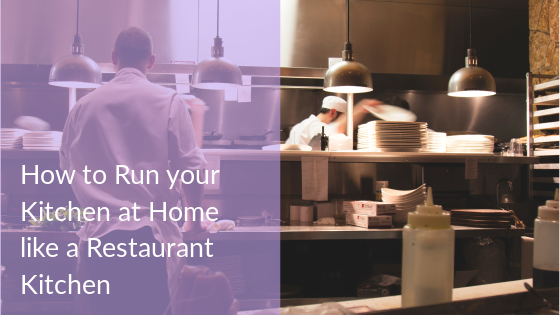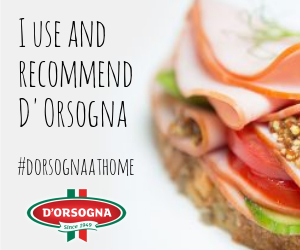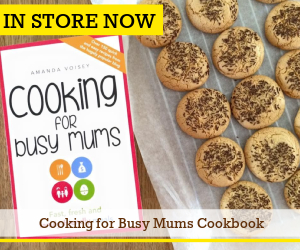Until my mid 20’s I had always work in the food/hospitality industry. From working in a shopping centre food court sandwich shop, to fast food (Hungry Jacks) to owning my own Cafe and then working for a coffee roasting company. I have always had a passion for food, I even wished that I could marry a chef when I owned the cafe (alas I didn’t meet my now husband who is a chef until after we sold the cafe). Top tip: don’t marry a chef, they won’t enjoy cooking for you at home hahaha.
In my mid 20’s I moved out of the food industry and into real estate which I still work in and love. Starting Cooking for Busy Mums when my first son was 4 months old was my way to still keep in touch with the food industry and indulge in my love for cooking while still working and raising a family.
While doing up my shopping list last Friday it dawned on me that I run my kitchen at home just like I would run my kitchen when I was working in the food industry. Running my home kitchen this way helps me to:
- minimise waste
- keep my food costs down
- get creative with leftovers
- and have it working efficiently
I am going to elaborate on how you can run your home kitchen just like a restaurant.
- MENU – this is your meal plan. While I do find meal planning a little “stuffy” I have realised that it eliminates a lot of nightly stress for dinners and when I grocery shop. So your meal plan is essentially just like a menu for a restaurant. You know what you are going to cook for the week and your family knows exactly what they will be eating eliminating that what is for dinner tonight question.
- SPECIALS – restaurants always have a specials menu. This specials menu is usually changed each day and it reflects what the chef has in the kitchen that they need to use up that day otherwise they will have to throw the food away. Your “specials” at home are your leftovers. I always plan one night that is a leftovers night and this is usually the night before my food shop. I pull everything out that needs to be eaten and everyone will either have a different meal or I will get creative and turn into in a new meal. This eliminates food wastage and essentially gives you a free meal.
- STOCK TAKE – this is knowing what you have in your fridge, freezer and pantry. You can do an official stock take where you write everything down that you have or do as I do. I have a glance through all the areas and see what I have the night before I do my groceries so I know what not to buy and what to buy.
- ORDER – at home this is your grocery shopping. Make a list – always make a list, never aimlessly wonder the aisles of a supermarket otherwise you will be the proud owner of the entire grocery store. Your meal plan, and stock take and the weekly catalogues will help you make your grocery list and help you stay on budget.
- FIFO – First In, First Out. Before you pack away your groceries make sure you rotate your “stock” so that you are using what will go out of date first. This will reduce the amount of food you have to throw away and you will know what needs to be eaten first.
- COOK – cook your meal plan. Above I mentioned about the meal plan sometimes feeling “Stuffy” what I mean is don’t feel restricted to having to cook exactly what you planned on that set day. I regularly swap meals around during the week but still stick to my meal plan of the ingredients I have bought to use for the week. Remember – don’t be afraid to have a “specials” night.
- CLEAN – a clean kitchen is happier more efficient kitchen to be in. In restaurants they thoroughly clean their kitchens every night/day. The cleanliness and organisation is not only for good food hygiene and safety it well help you enjoy cooking more. Every night I wipe over all bench top surfaces, wipe out the sink with an anti bacterial spray, load the dishwashers or wash the dishes, take the rubbish out, replace the hand towel etc. Doing it every night means your kitchen is ready to go in the morning and I feel so much happier walking out to a clean kitchen.
So there you have it, 7 things I do in my kitchen that are just like those of a restaurant kitchen. If your not doing them already, give them a try. Let me know how they have helped you improve your budget, efficiency, food wastage etc.
Find all my dinner recipes here.





















Hi Amanda,
I really liked this post. I’d like more info on how to run a kitchen at home like a restaurant.
How do you shop to a budget for a household? We’re on a low income at the moment and I’d like to get a better handle on how to manage our limited grocery budget for our family.
Often the ‘grocery’ budget also has to cover things like cleaning products, bathroom products, batteries and lightbulbs… It’s not just food for meals. And when the pantry staples run out, they need to be replenished periodically too. Do you work out a cost-per-meal budget or anything like that? With your professional background in mind, what is your approach budget-wise when you are meal planning and doing your grocery list?
Thanks 🙂
Melanie
Hi Melanie, one of the main things I learnt when running my own cafe that helped save money was to buy items that I could use for multiple dishes that were on the menu. To replicate this for home cooking and to save money simple things like, buying 1 kilo of mince and then using 500gm for spaghetti bolognese and the other 500gm for hamburgers later in the week. At $12 for the kilo of mince each meals may component will cost $6 and then you bulk it up with vegetables in the spaghetti bolognese and salad in the burgers. You will come in at roughly $10-$12 for each meal that will feed 5.
I will aim to get more of my ways to save on the blog ASAP. Amanda